
Des Moines is the capital and the most populous city in the U.S. state of Iowa. It is also the county seat of Polk County. A small part of the city extends into Warren County. It was incorporated on September 22, 1851, as Fort Des Moines, which was shortened to "Des Moines" in 1857. It is located on, and named after, the Des Moines River, which likely was adapted from the early French name, Rivière des Moines, meaning "River of the Monks". The city's population was 214,237 as of the 2019 population estimate. The six-county metropolitan area is ranked 83rd in terms of population in the United States with 699,292 residents according to the 2019 estimate by the United States Census Bureau, and is the largest metropolitan area fully located within the state.

Norman Ernest Borlaug was an American agronomist who led initiatives worldwide that contributed to the extensive increases in agricultural production termed the Green Revolution. Borlaug was awarded multiple honors for his work, including the Nobel Peace Prize, the Presidential Medal of Freedom and the Congressional Gold Medal.

Terrace Hill, also known as Hubbell Mansion, Benjamin F. Allen House or the Iowa Governor's Mansion, is the official residence of the Governor of Iowa, United States. Located at 2300 Grand Avenue in Des Moines, it is an example of Second Empire architecture. The home measures 18,000 square feet. It sits on a hill overlooking downtown Des Moines, and has a 90-foot (27 m) tower that offers a commanding view of the city. The building's steeply pitched mansard roof, open verandas, long and narrow and frequently paired windows, and bracketed eaves give this house an irreplaceable design. The house was designated a National Historic Landmark in 2003.

The World Food Prize is an international award recognizing the achievements of individuals who have advanced human development by improving the quality, quantity, or availability of food in the world. Since 1987, the prize has been awarded annually to recognize contributions in any field involved in the world food supply: Animal Science/Aqua Culture, Soil Science/Water/Conservation, Nutrition/Health, Plant Science/Seed Science, Plant Pathology/Crop Protection, Food Technology/Food Safety, Policy/Research/Extension, Infrastructure/Emergency Relief, & Poverty Alleviation/Hunger. The World Food Prize Foundation is currently run by Barbara Stinson. Ms. Stinson previously served as a co-founder and Senior Partner of the Meridian Institute, a renowned non-profit organization that guides collaboration and drives action to address our world's most complex challenges. She will succeed Ambassador Kenneth M. Quinn, whose 20-year presidency established the international reputation and secured the legacy of the World Food Prize. Ms. Stinson will become the second president of the Foundation since Dr. Norman Borlaug established it in 1986.

The Iowa State Capitol, commonly called the Iowa Statehouse, is in Iowa's capital city, Des Moines. As the seat of the Iowa General Assembly, the building houses the Iowa Senate, Iowa House of Representatives, the Office of the Governor, and the Offices of the Attorney General, Auditor, Treasurer, and Secretary of State. The building also includes a chamber for the Iowa Supreme Court, although court activities usually take place in the neighboring Iowa Supreme Court building. The building was constructed between 1871 and 1886, and is the only five-domed capitol in the country.

The Woodbury County Courthouse is located at 620 Douglas Street in Sioux City, the county seat of Woodbury County, Iowa, United States. It is regarded as "one of the finest Prairie School buildings in the United States" and has been declared a National Historic Landmark for its architecture. It is used for legal proceedings in the county.

The United States Post Office and Courthouse, Dubuque, Iowa is a courthouse of the United States District Court for the Northern District of Iowa located in Dubuque, Iowa. Completed in 1934, it was listed in the National Register of Historic Places in 1985. It is a contributing resource within the Cathedral Historic District.
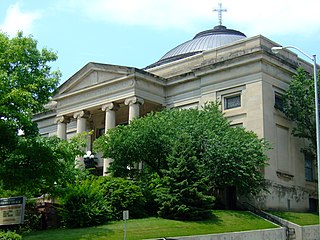
Proudfoot & Bird et al. was an American architectural firm or partnership that designed many buildings in the U.S. Midwest. Partners included Willis Thomas Proudfoot (1860–1928) and George Washington Bird (1854–1953) and Harry Dustan Rawson (1872–1934). At times it was known as Proudfoot, Bird and Rawson, Proudfoot, Rawson & Souers, Proudfoot, Rawson, Souers & Thomas,Monheim, Bird & Proudfoot, Proudfoot, Rawson Brooks & Borg, Brooks - Borg Architects - Engineers, Brooks Borg and Skiles Architects Engineers, and finally BBS Architects|Engineers.

The Des Moines City Hall in Des Moines, Iowa, United States was built in 1909-1910. It was individually listed on the National Register of Historic Places on November 10, 1977 as the Municipal Building, and became a contributing property in the Civic Center Historic District in 1988. The building serves as the seat for the government of the city of Des Moines. Beginning April 7, 2016, City Hall offices were temporarily relocated while the building underwent renovation. The construction was necessary to install modern heating, cooling, and sprinkler systems while preserving the historic character of the building. The project was expected to take 18–24 months. During that time, City Hall was closed to the public, and City offices moved to other nearby locations. Between February 26, 2018 and April 9, 2018, City offices moved back to City Hall.
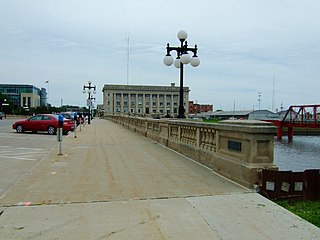
The Civic Center Historic District is located in downtown Des Moines, Iowa, United States. It flanks both the Des Moines and Raccoon Rivers and their confluence. The district has been listed on the National Register of Historic Places since 1988. It is part of The City Beautiful Movement and City Planning in Des Moines, Iowa 1892—1938 MPS.
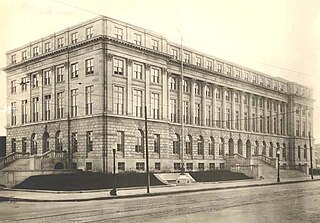
The United States Courthouse, located in Des Moines, Iowa, is the headquarters for the United States District Court for the Southern District of Iowa. It is part of the Civic Center Historic District that was listed on the National Register of Historic Places in 1988.

The Drake University Campus Historic District is located in Des Moines, Iowa, United States. The historic district contains six buildings. Five of the buildings are collegiate buildings on the Drake University campus and one is a church. The period of significance is from when the university was founded in 1881 to the end of the presidency of Hill M. Bell in 1918. The historic district has been listed on the National Register of Historic Places since 1988. It is part of the Drake University and Related Properties in Des Moines, Iowa, 1881—1918 MPS.

The Des Moines Public Library (DMPL) is the public library system for the city of Des Moines, Iowa. It is the largest public library system in the state of Iowa, with a collection of 552,576 items housed at six locations.
Frank E. Wetherell (1869-1961) was an architect in the U.S. state of Iowa who worked during 1892–1931. He founded the second oldest architectural firm in the state in Des Moines, Iowa, in 1905. He worked with Roland Harrison in partnership Wetherell & Harrison. The firm designed numerous Masonic buildings.

The E. H. Gibbs House, was built in 1903 in Oskaloosa, Iowa. It was designed by Frank E. Wetherell in Classical Revival architecture. It was listed on the National Register of Historic Places in 1991.

The Burlington Public Library is a public library located in Burlington, Iowa, United States. It dates back to 1868. The library is currently located on Court Street. The previous library building on Fourth Street was individually listed on the National Register of Historic Places in 1975. It was then added as a contributing property in the Heritage Hill Historic District in 1982.
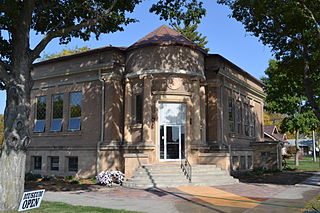
The Eagle Grove Public Library, now the Eagle Grove Historical Museum, is a historical building in Eagle Grove, Iowa, United States. A subscription library was begun in Eagle Grove around 1885, and housed in the post office. The impetus for the first free public library was a 1901 advertising campaign by a Des Moines insurance and investment company. When local citizens bought company's bonds, the company donated 250 books to the town. The books were housed in the Masonic Hall. The Carnegie Corporation of New York accepted Eagle Grove's application for a grant for $10,000 to build a library building on April 26, 1902. It was designed by the Des Moines architectural firm Smith & Gage in the Beaux Arts style. The library was dedicated on September 15, 1903. It is a brick structure with a conical-roofed entrance pavilion. Four engaged columns in the Ionic order flank the main entryway. The public library has subsequently moved to a larger facility, and the old library building was turned over to the local historical society for a museum. The building was listed on the National Register of Historic Places in 1983.
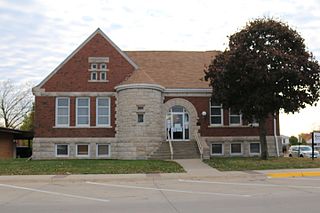
The Former Mount Pleasant Public Library is a historic building located in Mount Pleasant, Iowa, United States. The library here was established in 1875. The community applied to Andrew Carnegie for a grant to build a new building, which was accepted on January 13, 1903. They were initially granted $10,000 and then were given a further $2,500. The Chicago architectural firm Patton & Miller designed the Romanesque Revival structure. They adapted Henry Hobson Richardson's Thomas Crane Public Library (1882) for this building. Unlike the Crane Library, this building is primarily brick with rough stone used for a short tower on the main facade and for the trim. It also features an asymmetrical grouping of intersecting gables. The building opened on Wednesday, February 22, 1905. An addition was built onto the rear of the building in 1926. It was designed by the Des Moines architectural firm of Dougher, Rich & Woodburn. The building was listed on the National Register of Historic Places in 1983. The library has subsequently moved to another facility and this building now houses a branch of Southeastern Community College.

The Indianola Carnegie Library is a historic building located in Indianola, Iowa, United States. In November 1902 the local library board submitted a grant application to Andrew Carnegie so they could build a new building. The $10,000 grant was approved on January 13, 1903, and $2,000 was added at a later date. The Indianola City Council agreed to allocate $1,000 a year toward its upkeep. They also bought two lots at the corner of Buxton and Boston. One of the lots was owned by the family of Hannah Babb, the city librarian. Local architect Frederick W. Keith designed the brick Neoclassical structure, and it was built by G.W. James. The library eventually outgrew the building and it was replaced in 1984. The Des Moines Metro Opera has their offices in the old Carnegie building. It was listed on the National Register of Historic Places in 2017.
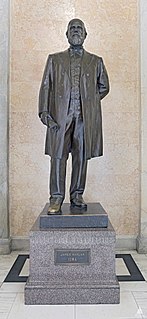
James Harlan is a bronze sculpture of American attorney and politician of the same name by Nellie Walker, formerly installed in Washington, D.C.'s United States Capitol, as part of the National Statuary Hall Collection. The statue, which was gifted by the U.S. state of Iowa in 1910, was replaced with one portraying Norman Borlaug in 2014.






















